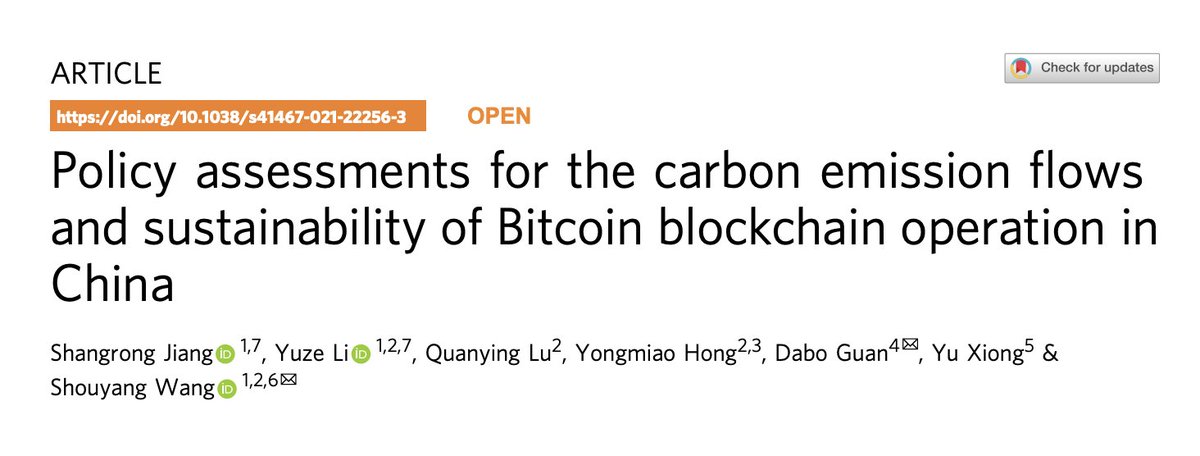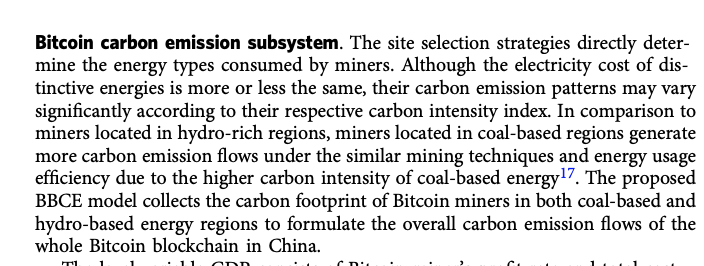The paper behind these breathless articles leaves a LOT to be desired. Brief thread https://www.bloomberg.com/news/articles/2021-04-06/bitcoin-blockchain-operations-in-china-threaten-climate-goals">https://www.bloomberg.com/news/arti...
This is the article in question. It doesn& #39;t really purport to rigorously quantify bitcoin& #39;s emissions. It offers black boxy simulations of bitcoin emissions under various regulatory scenarios.
https://www.nature.com/articles/s41467-021-22256-3.pdf">https://www.nature.com/articles/...
https://www.nature.com/articles/s41467-021-22256-3.pdf">https://www.nature.com/articles/...
As anyone knows, if you want to understand bitcoin c02 impact, you need to 1. identify where it is being mined and 2. identify the energy mix that those miners are using. This paper doesn& #39;t attempt to do either
I expected most of the paper to be about province-level data covering energy mix of Chinese miners. But that& #39;s missing. Instead, they claim to have taken this into account... but don& #39;t show their work (!) They just assert they& #39;ve quantified this
(The paper they cite there, footnote 17, is Krause and Tolaymat 2018, which naively assumes a blanket homogenous energy mix for China. Obviously wrong. So if they& #39;re leaning on the Krause methodology they& #39;re way way off base. But it& #39;s not clear, because they don& #39;t elaborate)
It& #39;s impossible to evaluate the key claim made in the paper – the relationship between energy outlay and c02 impact – because the authors don& #39;t present any data. This isn& #39;t an energy paper. The necessary component is just not there.
Other questionable things: the authors naively assume Chinese hashrate is 70% of Bitcoin mining because of pool data from http://BTC.com"> http://BTC.com . Also a crazy assumption. Pools ≠ mining machines. More sloppy reasoning
In the category of crazy assumptions, the following is an actual passage from the paper. Read it carefully. I want it to really sink in for you:
"Bitcoin blockchain reward halving occurs every four years, which means that the reward of broadcasting a new block in Bitcoin blockchain will be zero in 2140. As a result, the Bitcoin market price increases periodically due to the halving mechanism of Bitcoin blockchain."
Yep, they& #39;re relying on the absolutely insane assumption that due to the halving, the bitcoin price will mechanically increase. This is a key cornerstone of the analysis, as they& #39;re projecting Bitcoin emissions in the future. This is meant to be a scientific paper.
If you want to forecast bitcoin emissions, you have to
a) forecast the price of bitcoin
b) forecast fees
c) project where bitcoin will be mined
d) project the energy mix of those miners
They haven& #39;t done any of these things convincingly. 0/4
a) forecast the price of bitcoin
b) forecast fees
c) project where bitcoin will be mined
d) project the energy mix of those miners
They haven& #39;t done any of these things convincingly. 0/4
This paper is confusingly written, contains very little data or original work, and no energy mix data, just bald assertions. It& #39;s completely illegitimate as a credible work to be cited. Journalists should read the papers they& #39;re citing next time.
There& #39;s a cycle, whereby academics produce incredibly questionable work, and journalists breathlessly launder their nonsense into the mainstream, without having read or understood the paper. It& #39;s all so tiresome.
How can you just assert this stuff? Do you know the price of Bitcoin in 2024? Fee rates? Miner location? Energy mix? You know all of those things for sure?
https://www.newscientist.com/article/2273672-bitcoin-mining-emissions-in-china-will-hit-130-million-tonnes-by-2024/">https://www.newscientist.com/article/2...
https://www.newscientist.com/article/2273672-bitcoin-mining-emissions-in-china-will-hit-130-million-tonnes-by-2024/">https://www.newscientist.com/article/2...

 Read on Twitter
Read on Twitter





